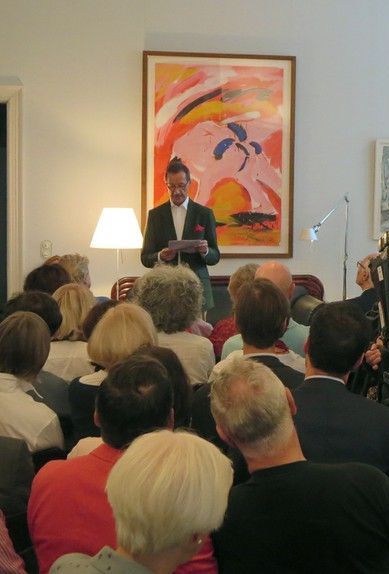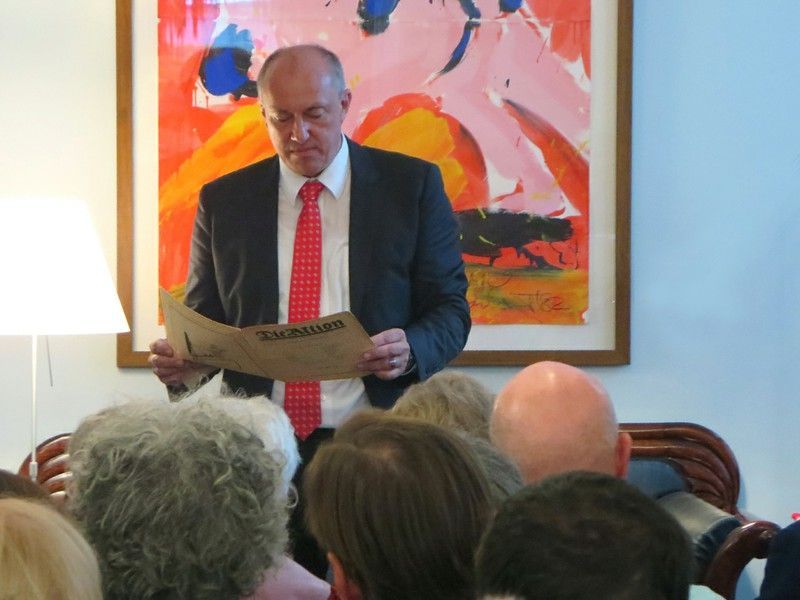Augsburger Strasse 21 in Berlin
Am 17. September 2016 wurde in der Augsburger Straße 21 (früher 48) in Berlin-Charlottenburg auf Initiative der Hausgemeinschaft (vielen Dank!) in Anwesenheit der Holocaust-Überlebenden Margot Friedländer eine Gedenktafel für Walter Serner enthüllt. Es ist die erste deutsche Gedenktafel für den 1942 ermordeten Schriftsteller und Dadaisten. In der Augsburger Straße begann Serners Berliner Zeit, hier arbeitete er für "Die Aktion" von Franz Pfemfert, den er wohl um die Ecke am Kurfürstendamm im Café des Westens ("Café Größenwahn") kennen lernte.
Margot Friedländer und die Walter Serner Gesellschaftt
Margot Friedländer, die wie Walter Serner nach Theresienstadt deportiert worden war, interessierte sich für Walter Serners Schicksal anlässlich der Gedenktafelenthüllung am 17.9.2016 in Berlin, zu der die Hausgemeinschaft sie eingeladen hatte. Sie nahm an der Veranstaltung regen Anteil. Wir kamen ins Gespräch und machten auch gleich ein Treffen mit Studierenden aus Leipzig aus, das schließlich am 28.11.2016 am Savignyplatz in einem Café stattfand. Sie las vor den Studierenden und anderen Gästen aus ihrem Buch vor und stand anschließend Rede und Antwort. In ihrer beeindruckenden bescheidenen Art konnte sie die jungen Leute schnell für sich und ihre Geschichte einnehmen. Unvergessen sind ihre abschließenden mahnenden Worte: "Was geschehen ist, ist geschehen. Jetzt seid ihr dran! Ihr müsst dafür sorgen, dass so etwas nie wieder passiert!" Wiederum über Vermittlung von Hans Gerhard Hannesen und Dieter Keller aus der Augsburger Strasse konnten wir sie schließlich dazu gewinnen, Ehrenmitglied unserer am 23.8.2022 in Berlin gegründeten Internationalen Walter Serner Gesellschaft zu werden. Dankbar nehmen wir Abschied von einer unermüdlichen Mahnerin, die vor allem viele junge Leute für ihr wichtiges Lebensthema begeistern konnte.
Leipzig, 10.5.2025 Prof. Dr. Andreas Mosbacher (Präsident der IWSG)


Margot Friedländer und Walter Serner in der New York Times vereint
Die New York Times berichtet in der Printausgabe vom 24. Oktober 2016 über die Veranstaltung im Beisein der Holocaust-Überlebenden Margot Friedländer (S. 6, Titel: "Germany Confronts, in a Unique Exhibit, Its ‘Holocaust of the Bullets’", von Alison Smale, online 23.10.2016; auf den Bildern links Hans Gerhard Hannesen von der Hausgemeinschaft, Andreas Mosbacher); hier ein Auszug:
"Margot Friedlander, 94, is one such survivor. Born in Berlin, she was hidden by Germans from 1943 to 1944 and then deported to Theresienstadt, the camp north of Prague where she met her future husband, Adolf Friedlander.
A rabbi married them in spring 1945 in Theresienstadt, and the next year they left for New York, where her husband helped run the 92nd Street Y for 28 years. After he died in 1997, she started writing her memoir, eventually published in German.
That led to a trip to Berlin, and a decision to stay. Visiting schools is perhaps the most important part of her new life, she said, “because they are the future.”
Ms. Friedlander was attending a gathering of about 60 people one Saturday morning in September. The crowd had assembled first outside the elegant apartment building at Augsburger Strasse 21 and then moved inside to the apartment where Walter Serner, a Dadaist writer, once lived.
Although Serner, born Walter Seligmann in Bohemia, converted to Catholicism in 1909, to the Nazis he was a Jew. In 1942, after an itinerant life, Serner and his wife were arrested and sent to Theresienstadt, and then on to the Latvian capital, Riga. Along with the 900 or so other Jews on their transport train, they were shot in a forest outside the city in August 1942.
The small ceremony to honor Serner was almost entirely made possible by the enthusiasm of Andreas Mosbacher, a judge and law professor who was struck several years ago by Serner’s work and fate.
What works might Serner have written had he lived, the guests wondered. “No one — or very few — has heard of him now,” Judge Mosbacher said. Like much of the art created in Theresienstadt, Serner’s writings attest to a use of the German language and artistic endeavor that has now withered.
In this respect, did Hitler’s efforts to mold German culture triumph?
Not if you listen to Ms. Friedlander, who has faith in the young. “What was, was,” she said. Now, “they are the ones who must shape society.”
Serner in der Abendschau (rbb)
Der rbb berichtete in der Abendschau über die gelungene Veranstaltung (auf dem Bild: Ansprache Dieter Keller von der Hausgemeinschaft). Über seine Ankunft in Berlin schreibt Serner später: "Kurz darauf [nach dem Studium in Wien] brachte ich einen Spielgewinn an der Hand eines Münchner Faschings durch und fuhr mit dem letzten Goldstück nach Berlin, wo ich mich 14 Tage hindurch langweilte, weil ich nachts schlief. Als ich anfing, es umgekehrt zu halten, amüsierte ich mich drei Jahre dermaßen, dass meine Liebe für diese Stadt ebenso unausrottbar bleibt wie für ihren Argot."